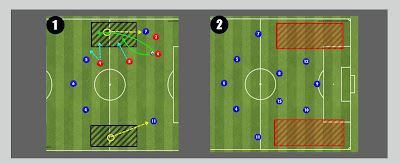1-There is no defensive midfielder. In other words,
they need a player who can take the ball from behind and carry it to the other
half of the pitch. If one of the centre midfielders approaches the defenders,
the other centre midfielder will be left alone (1). Therefore, left and right centre-backs
should be able to move the ball to other areas by approaching the midfield (2).
2-It is not a suitable formation for centre forwards.
Because what is expected from 3 attackers is that they are constantly moving,
changing places and sometimes going to the wings (1). Forwards, who only want
to be effective in and around the penalty area, have difficulty scoring goals
in this formation. The most important thing for the centre forward to do other
than to score is to find space for the 2 players behind him. When the defenders
move away from the penalty area or distract them, the other 2 players look for
a way to enter the box (2).
3-It is a new point of view not to choose wing-backs
in this formation. Centre midfielders are preferred on the wings. There are 2
reasons for this. First, the attack is mostly from the centre, and in addition
to the 3 forwards, centre midfielders or centre-backs contribute to the attack.
Centre midfielders on the wings only play defensively in this zone (1). The
second reason is that they do not go too far on either attack or defence, and
they automatically seize the unused regions in many formations and set the game
from these regions when switching from defence to attack-attack to defence (2).
4-The centre-back which is in the middle should not
wait too much behind the other centre-backs. Because when the opposing player
sends the ball between the two centre-backs, the opposing forwards run to these
areas and the probability of being caught offside decreases (1). If that centre-back
is behind and the opposing forward meets the ball, he must immediately block
his running path and allow time for his teammates to come to the defence (2).
5-One of the wing-backs must be a fullback and the
other a winger. If they're both wingers, it's always dangerous when the
opposing team comes from the wing (1). If they're both fullbacks, you're less
likely to attack from the wings. Because all three attacking players are centre
forwards (2).
6-It is easier for the team to defend in this
formation. Because when players come back, the distances between them are small.
The wing-backs come back, the defenders become 5. The centre midfielders come
back and block the penalty area, the opposing team cannot find an area to
attack (1). Attacking midfielders approach the midfield and make it easier for
the team to start counter attacks. The centre-forward always turns to the gaps
in the other half (2).
7-When a wingback wants to join the attack, he must
wait for centre-backs to approach him (1). If they lose the ball during the
attack and even if the wing-back is in the third zone, the opposing team cannot
start the attack from that zone, as the centre-back is waiting in the midfield
(2).
8-When one of the attacking midfielders and the centre
forward goes to the wing, the centre-back and wing-back run to the area called
the half-space. These changes force the opposing team. Because the opposing
defenders have to go to the wing and the midfielders to the defence. If they
don't, large gaps will soon appear. Even if they make these changes, the
balance of the defence will be broken.












Comments
Post a Comment